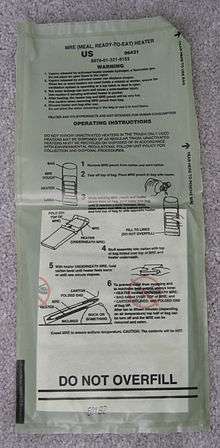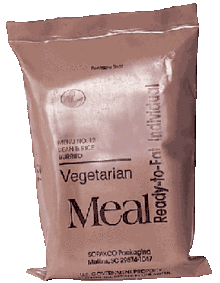Flameless ration heater
A flameless ration heater (FRH), is a water-activated exothermic chemical heater included with meals, ready-to-eat (MREs), used to heat the food. United States military specifications for the heater require it be capable of raising the temperature of an 8-ounce (226.8 g) entrée (American English for main course) by 100 °F (38 °C) in twelve minutes, and that it has no visible flame.

The ration heater contains finely powdered magnesium metal, alloyed with a small amount of iron, and table salt. To activate the reaction, a small amount of water is added, and the boiling point of water is quickly reached as the reaction proceeds.[1]
Chemical reaction
Ration heaters generate heat in an electron-transfer process called an oxidation-reduction reaction. Water oxidizes magnesium metal, according to the following chemical reaction:
- Mg + 2H2O → Mg(OH)2 + H2 [+ heat (q)]
This reaction is analogous to iron being rusted by oxygen, and proceeds at about the same slow rate, which is too slow to generate usable heat. To accelerate the reaction, metallic iron particles and table salt (NaCl) are mixed with the magnesium particles.[2][3][4]
Iron and magnesium metals, when suspended in an electrolyte, form a galvanic cell that can generate electricity. When water is added to a ration heater, it dissolves the salt to form a salt-water electrolyte, thereby turning each particle of magnesium and iron into a tiny battery. Because the magnesium and iron particles are in contact, they become thousands of tiny short-circuited batteries, which quickly burn out, producing heat in a process the patent holders call "supercorroding galvanic cells".
One brand of self-heating rations uses 7.5 grams of a powdered magnesium-iron alloy, consisting of 95 % magnesium and 5 % iron by weight, 0.5 grams of salt, in addition to an inner filler and anti-foaming agent. Upon adding 30 milliliters of water, this mixture can heat a 230 gram meal packet by 100 °F (38 °C) in about 10 minutes, releasing approximately 50 kilojoules of heat energy at about 80 watts.[5]
Confined space hazard
The United States Department of Transportation (DOT) Federal Aviation Administration (FAA) conducted testing and released a report which in summary states "... the release of hydrogen gas from these flameless ration heaters is of a sufficient quantity to pose a potential hazard on board a passenger aircraft."[6] This testing was performed on commercial grade 'heater meals' which consisted of an unenclosed flameless heat pouch, a bag of salt water, a styrofoam saucer/tray and a meal in a sealed, microwavable/boilable bowl.
References
- Brain, Marshall (15 April 2003). "How MREs Work". Howstuffworks. Retrieved 2014-09-12.
- Scott, Dan (February 1992). "Hot Meals" (PDF). Chem Matters. Retrieved 2014-09-12.
- US patent 4017414, Stanley A. Black & James F. Jenkins, "Powdered metal source for production of heat and hydrogen gas", published 1977-04-12, assigned to The United States Of America As Represented By The Secretary Of The Navy
- US patent 4264362, Sergius S. Sergev, Stanley A. Black, James F. Jenkins, "Supercorroding galvanic cell alloys for generation of heat and gas", published 1981-04-28, assigned to The United States Of America As Represented By The Secretary Of The Navy
- US patent 5611329, Marc Lamensdorf, "Flameless heater and method of making same", published 1997-03-18, assigned to Truetech, Inc.
- Summer, Steven M. (June 2006). "The Fire Safety Hazard of the Use of Flameless Ration Heaters Onboard Commercial Aircraft, DOT/FAA/AR-TN06/18" (PDF). Federal Aviation Administration. Retrieved 2008-03-09.
